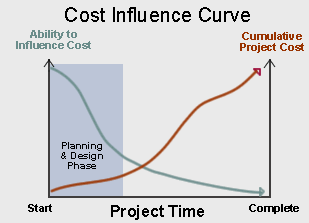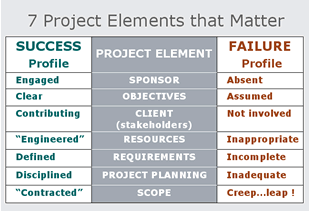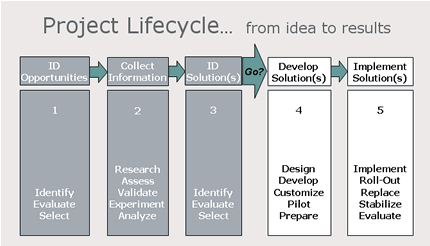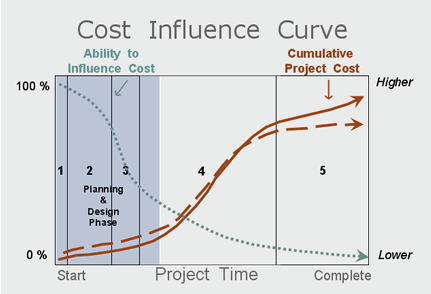

What exactly is Front-End Loading (FEL)?
We know that what happens in the first 30% of a project significantly influences the project's outcome. Front-end loading (FEL) defines the dimensions of the business opportunity, as well as the working relationships of the project's key stakeholders --- early in the project. Very compatible with SIX SIGMA practices, FEL applies high quality effort to the project's early definition activities. Front-end loading brings clarity to the project's WHY, WHAT, WHO, WHEN, and HOW questions. Why do Front-End Loading (FEL) practices influence project outcomes?
The simple answer is that FEL reduces project risk. FEL dramatically increases critical information early enough to position the project for success. Front-End loading practices fully exploit the window of time in which it is relatively inexpensive to shape the project's outcome (blue rectangle in the Cost Influence Curve visual). Which project elements should receive attention in
Front-End Loading? Project success rates hover in the 20-45% range. Studies continue to show that a handful of critical elements make or break most projects. All of these critical elements share a common thread. They are shaped by human decisions and omissions early in the project. Seven of the most critical project elements and their respective success/failure profiles are shown below. Skillfully applied, FEL creates the success profile for the project.  In practice, many projects, large and small find themselves in the failure profile, often due to schedule pressure. The project team that skips essential definition activities has sealed its fate --- long before the solution deliverables are implemented. Projects that start poorly do not reach their ROI. Where does Front-end loading occur in the project life-cycle?
As an example, if we are using a 5-stage project life-cycle (see below), FEL occurs during the first 3 stages. FEL prepares the project sponsor(s) to make a sound business decision about funding or not funding, i.e., “Go” or “No Go”, following stage 3 of the project. 
Now, by inserting the project life-cycle into the Cost Influence Curve (note stage numbers 1-5), we can see below just how early project definition must occur (blue shading).  The construction world has understood the benefits of FEL since the 1970's. One of the earliest to report the connection between FEL and project outcomes, Boyd Paulson suggested that spending a little more time and money early in the project (see dashed project expense arrow) was a prudent approach to reducing overall project costs in construction. In the last few decades, project professionals in other disciplines have begun to appreciate the positive impact that FEL can make on project results. However, front-end loading practices are not yet common in service organizations. As the pressure to deliver ROI accelerates, we predict that service organizations will begin to use FEL to improve project performance. |
Contact us to learn more about FEL.
© 2003-2013 THREE HOUSES CONSULTING LLC. All rights
reserved.